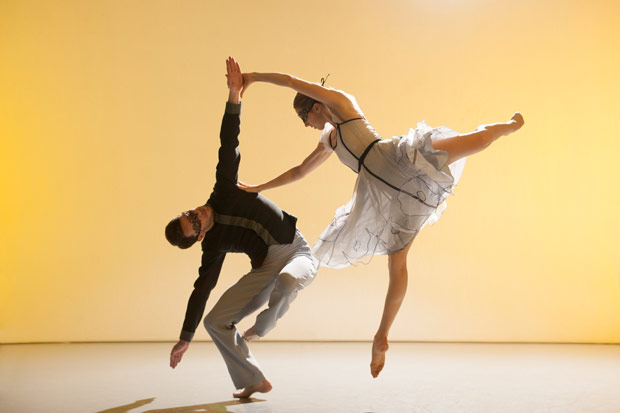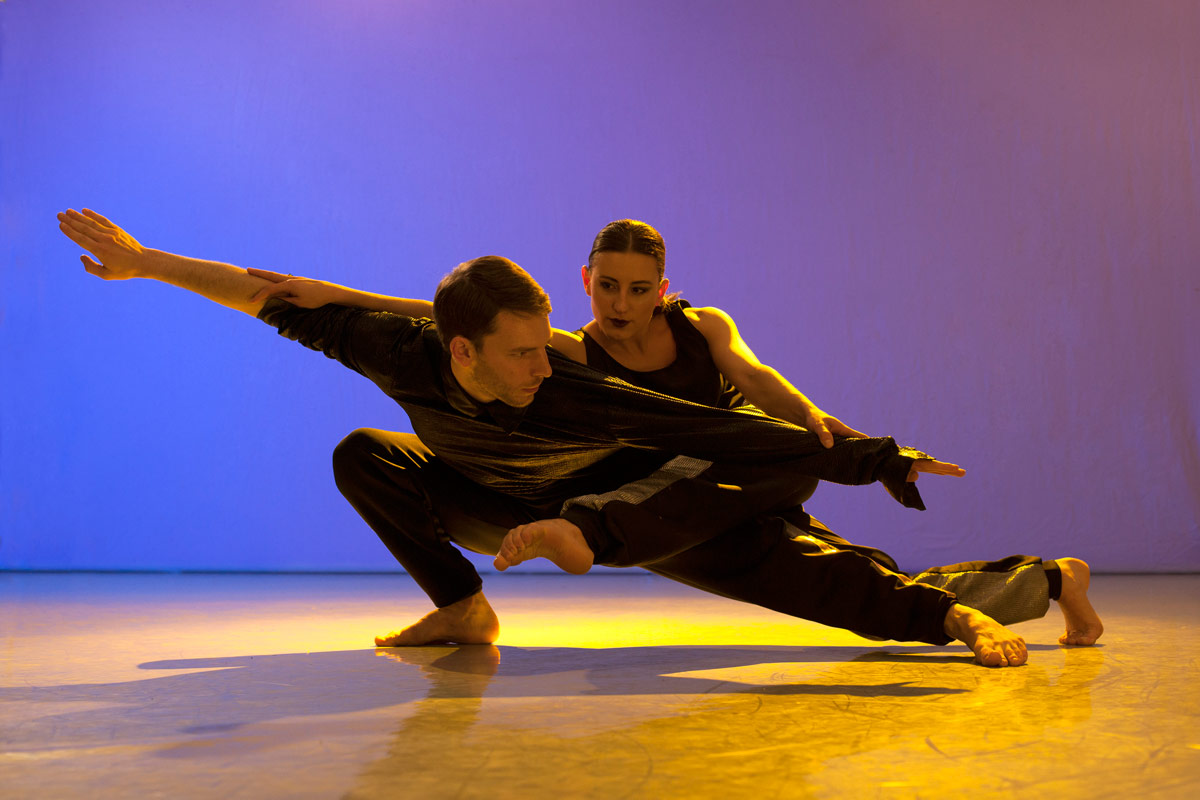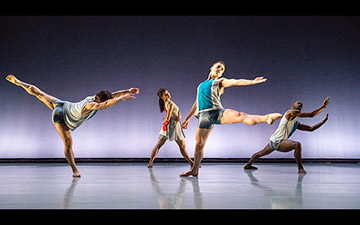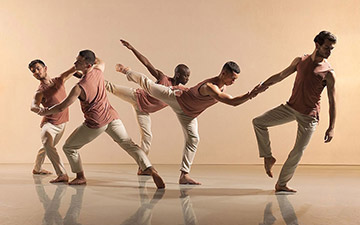
© Chris Nash. (Click image for larger version)
Richard Alston Dance Company
Mid Century Modern, Carnaval, Cut and Run
★★★★★
London, Sadler’s Wells
23 March 2018
www.richardalstondance.com
www.sadlerswells.com
It must be tempting to get carried away by sentiment when it comes to celebrating both a 70th birthday and fifty years as a choreographer in a programme that also marks the departure of a special muse. Richard Alston hasn’t yet reached the milestone of three-score-years-and ten; that birthday doesn’t arrive until later this year but he has passed the fiftieth anniversary of that first work, Transit, which was presented on 18 February 1968.
Mid Century Modern is both the name of the overall programme and its final work, being a well-constructed platform that pieced together excerpts from seven dances, essentially covering all five decades of Alston’s choreography. The title is an apt summary – in three words – looking back in celebration but recognising the future (Modern), which also summarises the choreographic output, but making it clear that it is not yet done (Mid).
And just to make sure that sentiment was kept in its place, the programme followed the convention of recent Alston seasons by including a new work from Associate Choreographer, Martin Lawrance – fresh from half-a-year’s sabbatical in the Philippines (where he has now made four works on Ballet Manila) – and a relatively new piece by Alston himself, which allows for movement inspired by some contemplation of past choreographic heroes.

© Chris Nash. (Click image for larger version)
There is an underlying synergy to Alston’s own half-century of choreography: the first quarter was spent in pursuit of knowledge, partly through his first company, Strider, but notably in an extended New York experience of the mid-70s; the second quarter was taken up curating and maintaining other people’s work – in addition to adding a few of his own – in the Rambert repertoire; and more or less half of his choreographic career, to date, has been making work on his own small company, in-house to The Place, which he began in 1993.
There are several givens that one can be sure of in any Alston programme: pitch-perfect musicality; fast, fluid movement in pure dance; an economy of substance in the setting; and a consistency of movement style. There is a thin line between the maintenance of a stylistic continuum and repetition but Alston traverses the challenge like Blondin crossing the Niagara gorge on a tightrope; achieved with a remarkable consistency and clarity of style, in the simple beauty of flowing movement. Programmes of recent years have attained a certain diversity in setting Alston’s work alongside a piece (usually, the opening work) by Lawrance but their focus on musicality is entirely complementary, each choreographic contribution to a programme tending to enhance the whole by emphasising the synergy in their respective choreographies.
Lawrance has returned from his sabbatical like a man in a hurry to make up for lost time and Cut and Run is a fast-paced work for the whole company of ten dancers. Lawrance has choreographed two pieces of music made for the cult, minimalist British band, Icebreaker: Michael Gordon’s Yo Shakespeare and Damian LeGassick’s Evol. The band has previous in terms of lending their music to dance, having played live for Ashley Page’s Cheating, lying, stealing at The Royal Ballet and for its revival at Scottish Ballet.
Lawrance’s great achievement here is to have taken the spiky, interrupted rhythmic structure of these works (Gordon pioneered the musical concept of a split triplet in a style that the composer described as ‘three salsa bands playing simultaneously at different but related speeds’) and matched it with a surprisingly disciplined exuberance in the movement style and structure, offsetting the visceral noise in the music with a flowing procession of miniature dances in duets, trios and larger groups.
A little bit of the Philippines returned with Lawrance since the Cut and Run costumes were designed by Filipino fashionista, Jeffrey Rogador: their black and gold sparkle further enlivening the work’s urgency; performed in a bare set, opened out to expose the wings, but made luscious through the range of vibrant colours painting the stage and back wall through Zeynep Kepekli’s excellent lighting.
Lawrance set a high standard for his mentor to follow but, in true Alston fashion, his new work, Carnaval, which premiered in Scotland, last autumn, changed the pace and style so completely, as to nullify any comparison. Choreographed to Robert Schumann’s eponymous early work, Alston plays with a narrative theme about the composer’s contemporaneous life. Schumann’s mental illness (he died in self-imposed confinement in an asylum, aged just 46) is represented by the imaginary figures he created in his critical writing, and which appear as motifs throughout Carnaval, representing his split personality, which the composer himself named as Florestan (representing turbulent passion) and Eusebius (the dreamer), being danced respectively by Nicholas Bodych and Liam Riddick.

© Chris Nash. (Click image for larger version)
At the time of writing Carnaval (1834), Schumann had fallen deeply in love (on the rebound from a failed engagement) with fifteen-year-old Clara Wieck, already a virtuoso concert pianist, but her father banned their liaisons (they eventually married, in 1840, on the day before her 21st birthday). Clara is represented in this strange ménage a trois, with a mix of emotional extremes (the confident, skilful child protégé and the sensitive bafflement of young love) through the sensitive dancing of Elly Braund.
Pianist, Jason Ridgway, performs Carnaval onstage with the trappings of the masked ball figuratively represented by hanging lights and in Fotini Dimou’s simple-yet-evocative costumes (Riddick wears an approximation of a dinner jacket, minus the tails). It is an exceptional new addition to the Alston repertoire, which he dedicated to the dance writer, the late David Vaughan, both Merce Cunningham’s archivist and Frederick Ashton’s biographer. Although the choreography was unmistakeably that of Alston, his heavy nod to Ashton’s steps and structures, accented by the playfulness of Cunningham shapes, made for a fun hunt-the-reference sideline.
The seven ages of Alston as defined in Mid Century Modern emphasised how much his principles have remained unchanged even though his range of movement continues to innovate, the secret being the vast spectrum of his musical inspiration. That first work, Transit, has long disappeared – the only remnant being the photo used on the programme cover (the sole face in clear view being that of Siobhan Davies) and so the earliest excerpt was a solo, entitled Departing in Yellow (from 1970’s Nowhere Slowly), recreated from a film of Celeste Dandeker performing the piece and danced by Jennifer Hayes. This had been preceded by a group extract from Rainbow Bandit (1977), a breakthrough work for Alston that built upon his New York experiences. A flavour of the inspiration derived from the Electric Gypsyland music of Gypsy Mixture (2004) – in my view, one of Alston’s finest group works – was given in a duet for Riddick and Monique Jonas, with a look to the future in their supporting pair being Sebastian Kapps and Madeleine Millar (still only second year students at London Contemporary Dance School).

© Elliott Franks. (Click image for larger version)
The repeated words of Wittgenstein (‘How small a thought it takes to fill a whole life’) in Steve Reich’s Proverb were the inspiration for an eponymous work that was performed twice-only at The Barbican, in 2006, to celebrate the composer’s 70th birthday. This extract for the whole company signposts Alston’s decision to revive the complete work, this autumn, to mark his own 70th birthday. Yet more synergy!
As if to show that looking forward is always the more rewarding, the most absorbing work in this septet was guest artist, Vidya Patel’s extraordinary solo, Syrinx, choreographed by Alston for this programme. Her momentum was maintained through Liam Riddick’s performance of the catchy, bouncy rhythms of Dutiful Ducks (a work made for Michael Clark, in 1982, and since revived on Jonathan Godard and, now, Riddick). Although Mid Century Modern continued with an ensemble finale to Handel’s music in The Signal of a Shake (and there had to be some joyful Baroque in the mix), the enduring memory of the evening will be the London premiere of Riddick performing those ‘Ducks’, since these were his last performances as a member of the Richard Alston Dance Company. After eight years, six National Dance Award nominations (winning Best Male Dancer, just last month), Riddick now moves on to the next chapter of his career; as a freelance dancer who will, no doubt, be in some considerable demand.
Alston will now fulfil a promise he made to the former director of The Place, Kenneth Tharp, to step down as artistic director of The Place on the day following his 70th birthday, at the beginning of November. However, he plans to carry on making work and overseeing his company and so, I suspect that – unless you are a Place “insider” – very little difference will be evident, at least for the next season and – we hope – for several years to come.

















You must be logged in to post a comment.